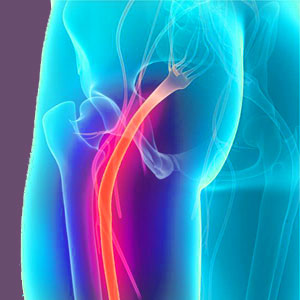
Piriformis symptoms can mimic sciatica, in cases of piriformis syndrome, or may entail soft tissue pain in the muscle itself or in the surrounding anatomy in cases of localized injury, RSI or muscular imbalances. The symptoms of piriformis syndrome are strikingly similar to expressions from many other dorsalgia diagnoses, including various causes of sciatica and pseudo-sciatica, as well as cauda equina syndrome or cervical spinal stenosis, when the pudendal nerve is involved. Meanwhile, symptoms of muscular imbalances, piriformis injury and RSI issues can mirror those of various other conditions, as well including buttocks pain, hip pain, sacroiliac pain and general lower back pain.
Diagnosing and treating piriformis-related pain conditions is a highly subjective science. Simply ascertaining that the piriformis is indeed the symptomatic source is already a substantial challenge for care providers who insist on providing evidence-based diagnosed conclusions.
This resource section examines the usual expressions of various piriformis symptoms. We will provide a thorough accounting of the typical and occasional symptoms seen in association with piriformis syndrome, piriformis injury and other related diagnoses.
Piriformis Syndrome Symptoms
Piriformis syndrome describes a condition wherein the piriformis muscle constricts and compresses the sciatic and/or pudendal nerves. Pain will not be experienced in the piriformis muscle itself in virtually all cases, but instead will be expressed in areas of the body served by the impinged nerves. These areas include the groin, buttocks, pelvis, perineum, legs and feet.
Most commonly, the sciatic nerve will be compressed, enacting a set of piriformis symptoms known as pseudo-sciatica. While identical to true spinally-motivated sciatica in expressed symptomology, the source of the pain is not of spinal origin, hence its “pseudo” designation. Symptoms will include pain, tingling, numbness or weakness in areas of the buttocks, legs, and/or feet unilaterally or bilaterally. Functional deficits might also occur, such as foot drop.
When the pudendal nerve is compressed, symptoms might be even more clinically significant, potentially resembling causes of cauda equina syndrome or severe cervical spinal stenosis. These symptoms might also include pseudo-sciatica expressions, but will possibly feature pain in the pelvis and groin, sexual dysfunction, constipation, urinary retention and incontinence of bladder or bowels.
Piriformis Muscle Symptoms
Symptoms might also be experienced locally in the piriformis muscle itself or in the surrounding soft tissue anatomy. In these cases, it is unlikely that piriformis syndrome is the root cause, but instead will probably entail muscular injury, RSI or muscle imbalance.
Symptoms of all of these conditions may include pain and paresthesia, often related to movement or anatomical positioning. Since the piriformis is instrumental in mobilizing the leg, general movement of the affected leg, and especially lateral rotation of the leg, are likely to induce discomfort.
Topical Discussions on Piriformis Symptoms
Below, we provide detailed views of many specific piriformis symptoms for further study. If you suspect the piriformis as a possible source of your pain, or have been diagnosed with such a verdict, then please enjoy the research opportunities these focused essays provide for symptomatic correlation. As each is complete, they will be added to the list below:
Piriformis buttocks pain usually occurs near the muscle, since the piriformis is indeed located deeply within the anatomy of the buttocks.
Piriformis leg pain might be diagnosed as sciatica and is a frequent symptom of several nerve compression diagnoses. Piriformis sciatica is a misnomer and should be referred to as pseudo-sciatica, as it originates in a source other than the spinal nerve roots from L4 to S3.
Piriformis foot pain is one of the least common symptoms of piriformis syndromes, but can exist in some patients through actions upon the sciatic nerve.
Piriformis hip pain is a common description of ambiguous pain n the greater region of the hip joint. Commonly implicated sources of hip pain are the hip itself, the sacroiliac and the piriformis muscle.
Piriformis knee pain is a relatively common symptom that may occasionally be misdiagnosed as a result of some incidental structural abnormality of the knee itself.
Piriformis tingling might also be called pins and needles and can be experienced locally or in any of the lower body regions often affected by pseudo-sciatica.
Piriformis numbness may be subjective or objective and often entails both expressions. Piriformis saddle paresthesia is a good indicator of possible compression of the pudendal nerve as the most logical mechanism of action.
Piriformis sexual dysfunction and constipation are other common signs of pudendal nerve entrapment.
Piriformis weak legs are the result of continued nerve compression or other mechanism affecting the sciatic nerve.
Piriformis burning sensations might exist in the greater hip and buttocks area or might radiate down the leg often on the posterior our outer side of the limb.
Get help for piriformis symptoms immediately. Our proprietary pain relief program can help you 24/7 from anywhere in the world.
Piriformis Pain > Piriformis Symptoms






